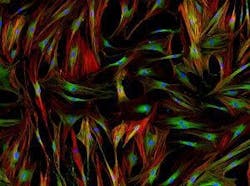Advancements in Live Cell Imaging: Oblique Illumination, AI, and Big Data
Key Takeaways:
- Oblique illumination technology optimizes the contrast, improving visual resolution and highlighting subtle cellular changes.
- Integration of AI algorithms enhances image processing efficiency and enables real-time monitoring of dynamic cellular changes.
- Big data analytics provide comprehensive insights into cell behavior, aiding in disease understanding and treatment strategies.
- The fusion of AI algorithms and big data analytics expands the scope of oblique illumination technology across various fields, fostering innovation in life sciences.
Advancements in Live Cell Imaging: Oblique Illumination, AI, and Big Data
Advancements in optical systems have propelled the field of live cell imaging, opening new frontiers in biomedical research. Key among these innovations is the utilization of oblique illumination, providing a richer and more nuanced dimension to cellular observations. Concurrently, the integration of artificial intelligence (AI) algorithms and big data analytics has further revolutionized the landscape of optical imaging, which enhances efficiency and expands the scope of insights gained.
Oblique illumination technology stands out for its ability to optimize contrast by rendering cellular components clearer and more distinct. This advantage is particularly evident in live cell imaging, where it not only improves visual resolution but also highlights subtle changes in cellular structures. This enhanced visualization equips researchers with precise tools to observe cellular dynamics during various developmental stages, disease states, and therapeutic interventions.
In comparison to traditional differential interference contrast (DIC) optical systems, oblique illumination’s broader application spectrum extends to handling diverse scenarios, including complex 3D tissue cultures and organ cultivation. Through adjustable components, a standard 2D microscope can seamlessly transform into a robust 3D visualization tool, offering comprehensive insights across neuroscience, vascular studies, pathology, and various other research domains.
The integration of AI algorithms has further elevated the capabilities of oblique illumination technology. By combining these technologies, researchers can significantly improve the efficiency of image processing and analysis. AI algorithms can identify and locate cellular structures in images, even automating cell segmentation and tracking for real-time monitoring of dynamic changes in live cells. This application of deep learning enhances the automation of cell imaging, allowing scientists more time to focus on interpreting experimental results and conducting in-depth research.
The introduction of big data analytics provides a broader perspective on cell imaging. By collecting and analyzing extensive data from cellular images, researchers can identify patterns and trends within cell populations, gaining a more comprehensive understanding of cell behavior. This thorough data analysis helps to uncover cellular responses in different environments, offering profound insights into disease development and treatment strategies.
The combination of AI algorithms and big data analytics also expands the possibilities of oblique illumination technology across various fields. In neuroscience, vascular research, pathology, and beyond, leveraging the power of big data enables researchers to better comprehend complex intercellular relationships. Supported by AI algorithms, researchers can accurately locate and analyze minute structures and changes within cells, providing more precise and reliable tools for the in-depth study of cell biology.
As technology evolves, the fusion of AI algorithms and big data analytics not only enhances the performance of optical systems but also opens new possibilities in the field of life sciences. This comprehensive application of technology is expected to inject more innovation into the realm of live cell imaging, fostering positive and far-reaching impacts on human health and scientific research. With this ongoing trend, we anticipate witnessing more advanced optical systems based on AI algorithms and big data analytics which will contribute to remarkable achievements in the exploration of life sciences.
